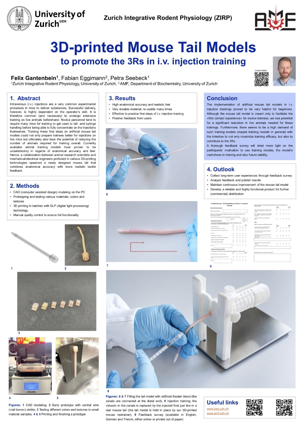3D printed mouse tails for i.v. injection
| Record number: | a9ab6 |
|---|---|
| Category: | |
| Type: |

Latest news: this model is now available for purchase from Vetiqo.
To perform i.v. injections on mice reliably, extensive training is required. This is usually performed on live animals. For the first steps of training (handling of syringes and the tail), 3D-printed mouse tail models can be useful placeholders instead of using live animals.
Current developments in 3D printing technologies and materials offer great potential for next-level physical training models in the field of laboratory animal sciences. Felix Gantenbein (University of Zurich Integrative Rodent Physiology, ZIRP) combined knowledge about the specific requirements of training rodent experimental procedures with the AddManFactory, offering expertise of state-of-the-art 3D printing to create realistic 3D printed mouse tails.
These artificial tails (containing vessels filled with artificial blood) can be used for i.v. injection trainings to a) train dexterity, b) familiarize with the necessary equipment and c) learn the technique step by step for as many repetitions as necessary before training on live animals. Artificial mouse tails present an excellent opportunity to implement animal-free learning tools into the training of basic skills required for many rodent experiments, thus reducing the number of animals used for training as well as the suffering of mice used for the final (in vivo) training step.
The project was supported by a grant from the Swiss 3RCC in 2022.
The development of this simulator is described in this video (subtitles in English, French and German).
A poster can be downloaded here, describing user feedback. Preliminary results indicate a high level of acceptance of the mouse tail model as a training device. However, the potential of artificial animal models to fully replace live animals for training is met with great scepticism. A refined, pigmented mouse tail model resembling the more commonly used C57Bl/6 mouse strain as well as a rat tail model are in development as a result of the feedback.
See also other vein simulators in NORINA.
Thanks for your feedback! Please note that we cannot reply to you unless you send us an email.
What are you looking for?
We value your feedback so we can improve the information on the page. Please add your email address if you would like a reply. Thank you in advance for your help.!
Please contact us by email if you have any questions.

